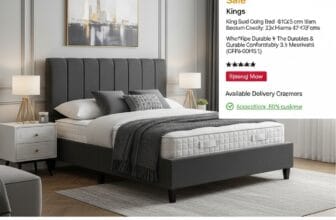
The Ultimate Guide to Finding the Perfect Bed Sale in the UK: Sleep Soundly Without Breaking the Bank
In our fast-paced, always-on world, a good night’s sleep isn’t just a luxury; it’s a fundamental pillar of our physical and mental wellbeing. It’s the time our bodies repair, our minds process, and our energy reserves are replenished for the day ahead. And at the heart of restorative sleep lies the one piece of furniture we spend a third of our lives on: our bed. Yet, despite its importance, the prospect of buying a new bed can often be a source of stress, largely due to the significant financial investment involved. But what if you could secure the bed of your dreams for a fraction of the price? Welcome to the wonderful world of the beds sale – your golden ticket to premium comfort without the premium price tag.
Navigating the landscape of bed sales, however, can feel like trying to find your way through a maze in the dark. With endless options, confusing jargon, and discounts that seem too good to be true, it’s easy to feel overwhelmed. This comprehensive guide is here to switch the light on. We’ll walk you through everything you need to know to become a savvy bed shopper, from pinpointing the absolute best time to buy, to decoding the technical terms, and choosing the perfect bed for your unique needs. Prepare to transform your sleep and your savings account.
When is the Best Time to Find a Beds Sale?
Timing, as they say, is everything. This is especially true in the world of retail, which operates on a surprisingly predictable cycle of promotions and clearances. By understanding this rhythm, you can strategically plan your purchase to coincide with the biggest reductions. Forget impulse buying; a little patience can save you hundreds, if not thousands, of pounds.

The Big Four: Prime Sales Seasons
- The January Sales: A classic for a reason. As the festive season fades, retailers are eager to clear out old stock to make way for the new year’s models. This is a fantastic time to find significant markdowns on beds and mattresses that were on the shop floor in the previous quarter. The post-Christmas lull in consumer spending means businesses are keen to entice you with compelling offers.
- Bank Holiday Bonanzas: Keep a close eye on the calendar for the three main Bank Holiday weekends: Easter, the late May Bank Holiday, and the August Bank Holiday. These three-day weekends are a huge deal for home and furniture retailers. They know people have extra time to browse and think about home improvements, so they launch some of their most competitive sales to capture this audience.
- Black Friday & Cyber Monday: What started as an American post-Thanksgiving tradition has firmly cemented itself as the UK’s biggest shopping event of the year. In late November, you can expect a frenzy of online and in-store deals. For beds, this can mean phenomenal price drops, bundle deals (e.g., free pillows or a discounted headboard with a mattress), and flash sales that are gone in a heartbeat.
- Summer Sales: Typically kicking off in late June and running through July and August, summer sales are another stock-clearing exercise. Retailers are preparing for the arrival of their autumn and winter collections, making it an opportune moment to snag a high-quality bed at a lower price.
The Savvy Shopper’s Secret: Off-Peak Opportunities
Beyond the major sales events, there are other moments to watch. Many bed manufacturers launch their brand-new models in the late spring, around May or June. This means that in the preceding months, from March to May, retailers are often quietly discounting the “outgoing” models to make space. This can be a secret sweet spot for finding a top-of-the-line bed from the previous year’s collection at a fantastic price.
Decoding the Jargon: A Buyer’s Glossary
Walking into a bed showroom or Browse online can feel like learning a new language. “Pocket sprung,” “hybrid,” “divan,” “ottoman” – what does it all mean? Understanding the terminology is the first step to making an informed choice and not being swayed by confusing sales patter.
Mattress Types Explained
- Pocket Sprung: This is a premium type of innerspring mattress. Each spring is housed in its own individual fabric pocket. The magic of this is that the springs work independently of each other. This means the mattress contours to your body shape with incredible precision, offering excellent support. It’s also the perfect choice if you share a bed, as it minimises motion transfer – so you won’t be disturbed when your partner tosses and turns.
- Memory Foam: Originally developed by NASA, memory foam (visco-elastic foam) responds to your body heat and pressure, moulding to your exact shape. This provides outstanding pressure relief, particularly for your hips, shoulders, and back, making you feel cradled and supported. The main consideration is that some people find traditional memory foam can retain heat, although newer versions often incorporate cooling gels or more breathable structures.
- Latex: Made from the sap of rubber trees (natural latex) or from synthetic materials, latex foam offers a different feel. It’s more buoyant and responsive than memory foam, giving you a feeling of sleeping “on” the mattress rather than “in” it. Latex is also naturally hypoallergenic, resistant to dust mites and mould, and extremely durable.
- Hybrid: Can’t decide between springs and foam? A hybrid mattress aims to give you the best of both worlds. It typically combines a base layer of pocket springs for that responsive support with top comfort layers of memory foam, latex, or gel. This combination often results in a mattress that offers both pressure relief and a supportive bounce.
- Open Coil: Also known as a Bonnell spring system, this is the most traditional and often most budget-friendly option. The springs are all interconnected in a single wire framework. While this provides good, firm support across the whole mattress, it’s less effective at minimising motion transfer and contouring to your body compared to pocket springs.
Bed Base Fundamentals
- Divan Base: A stalwart of British bedrooms, the divan is essentially a sturdy wooden box, upholstered in fabric, that your mattress sits on top of. They often come in two separate parts that are linked together, making them easier to get up tricky staircases. Their biggest selling point is the integrated storage, which can come as two or four drawers, or as larger continental drawers.
- Bedstead (or Bed Frame): This is what most people picture when they think of a traditional bed. It’s a frame, typically made of wood, metal, or upholstered material, that has a headboard, footboard (or foot end), and side rails. The mattress is supported by wooden or metal slats that run across the frame. Bedsteads offer a huge range of styles, from classic wooden sleigh beds to minimalist metal frames.
- Ottoman Base: For those who crave maximum storage, the ottoman is the undisputed champion. The entire top of the base, including the mattress, lifts up with the help of hydraulic gas-lift pistons, revealing a vast, empty storage space underneath. It’s the perfect solution for hiding away spare bedding, towels, or seasonal clothes in smaller rooms.
Finding Your Perfect Match: How to Choose the Right Bed
Now that you speak the language, it’s time to find the bed that’s right for you. This is a deeply personal choice that depends on your body, your sleeping style, and your lifestyle.
It’s All About the Mattress Tension
Mattress firmness is not about quality; it’s about suitability. What feels like a cloud to one person can feel like a rock to another. The right tension for you is determined by your sleeping position and your body weight.
- Soft to Medium: Generally best for side sleepers. When you sleep on your side, your hips and shoulders are the main pressure points. A softer surface allows these to sink in slightly, keeping your spine in a straight, neutral alignment.
- Medium to Firm: A great all-rounder, but particularly good for back sleepers. It provides enough give for comfort while being solid enough to support the lower back and maintain the natural curve of your spine.
- Firm to Extra Firm: Often recommended for those who sleep on their stomach or people with a heavier body weight. A firmer surface prevents your torso from sinking too deeply into the mattress, which can cause your spine to arch uncomfortably.
Size Matters: From Single to Super King
Choosing the right size is a balance between your personal comfort and the dimensions of your bedroom. Always measure your space before you shop!
- Single (90cm x 190cm): Perfect for children, guest rooms, or smaller single-person bedrooms.
- Small Double (120cm x 190cm): A great option for solo sleepers who want a bit more room to stretch out, or for couples in a very compact bedroom. Also known as a ‘Queen’ in some circles.
- Double (135cm x 190cm): The most common size in the UK, suitable for most couples.
- King (150cm x 200cm): A touch wider and, crucially, longer than a standard double. That extra length can make a world of difference for taller people.
- Super King (180cm x 200cm): The height of luxury. It offers an abundance of space for couples, ensuring an undisturbed night’s sleep even if one of you is a restless sleeper.
The Great Debate: Buying Your Bed Online vs. In-Store
The modern marketplace gives you two main avenues for your purchase. Both have distinct advantages and potential pitfalls.
The In-Store Experience: The “Lie Down Test”
There’s no substitute for physically trying before you buy. Visiting a high street retailer or a retail park superstore allows you to perform the crucial “lie down test.”
Pros: You can feel the mattress tension, see the exact colour of the upholstery, and get face-to-face advice from a salesperson. You can compare different models side-by-side in real-time. Cons: Prices can be higher due to store overheads, you might feel pressured by salespeople, and the selection is limited to what’s on the floor.
Top Tip: When you go shopping, wear comfortable clothing. Don’t just sit on the edge and bounce – lie down properly in your usual sleeping position for at least 10 minutes to get a real feel for the bed.
The Online Advantage: Choice and Convenience
The rise of the “bed in a box” and online-only furniture stores has revolutionised the industry.
Pros: The selection is virtually limitless, and prices are often incredibly competitive. You can shop from the comfort of your sofa, and the bed is delivered directly to your door. The game-changer has been the introduction of risk-free trial periods, often lasting 100 nights or even a full year, allowing you to test the bed in your own home. Cons: You can’t try it before you buy, which can feel like a gamble. While returns are possible during the trial period, organising the collection of a mattress can sometimes be a logistical hassle.
Top Tip: If buying online, become a review detective. Read customer reviews on the retailer’s site and on independent platforms. Check the returns policy with a fine-tooth comb and look for a mattress that is approved by the National Bed Federation (NBF), which ensures it meets UK standards for safety, quality, and trade descriptions.
Mastering the Sale: Pro Tips for Getting the Best Deal
You’ve timed it right, you know what you want – now it’s time to ensure you get the absolute best value for your money.
- Look Beyond the Headline Discount: A “70% OFF!” banner is enticing, but what was the original price? Some retailers use an inflated Recommended Retail Price (RRP) to make discounts look bigger than they are. Your focus should be on the final price you pay and how it compares to similar products elsewhere.
- Ask About Bundle Deals: Even if not advertised, always ask if there’s a discount for buying a complete set – a mattress, base, and headboard together. You might also be able to get pillows, a duvet, or a mattress protector thrown in.
- Factor in Delivery and Removal: Is delivery free? Many places offer free delivery to your doorstep, but some charge extra for a “white glove” service that takes it to your room of choice and assembles it. Also, check the cost of their old bed removal service. These charges can add a significant hidden cost.
- Understand the Guarantee: A guarantee or warranty is a promise of quality. Check the length (a good mattress should have a guarantee of at least 5-10 years) and, more importantly, what it covers. For example, how much dipping or sagging is considered a fault?
Conclusion: Your Journey to a Dreamy Night’s Sleep
Buying a new bed is one of the most important investments you can make in your health and happiness. By approaching the process with knowledge and strategy, you can avoid the pitfalls and emerge victorious with a bed that feels like a dream, at a price that lets you sleep easy. Remember the key principles: time your purchase to hit the big sales, learn the language of beds to know what you’re really buying, choose a mattress and base that are perfectly suited to your body and your space, and be a savvy shopper who looks at the total value, not just the flashy discount. Your journey to a truly restorative night’s sleep starts here. Sweet dreams.







